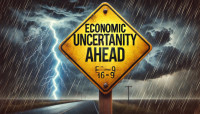In This Article:
- Who is to blame for today’s financial inequality?
- How does wealth inequality impact your daily life?
- What happened to the American Dream of the 1950s?
- Why are student debt and low wages at crisis levels?
- What solutions exist for addressing systemic financial inequality?
Why the System Feels Rigged To Young People
by Robert Jennings, Innerself.com
Remember when the American Dream meant something? When one income could buy you a home, put food on the table, and send your kids to college without breaking a sweat? Yeah, me neither—it’s been that long. Today, the dream is less “white picket fence” and more “please don’t overdraft my account.” And while the wealthy are busy buying second yachts and escaping to private islands, the rest of us are stuck reinventing what it means to “succeed.”
Welcome to 2025, where financial wellness is all the rage. It’s not about getting rich anymore—no, that’s for the top 1%. The rest of us are focused on simply staying afloat without drowning in debt-induced despair. Think of financial wellness as the participation trophy of economics: you’re not winning, but hey, at least you’re not completely losing.
The 1950s: One Job, One Dream
Let’s take a stroll down memory lane to the 1950s, the golden era of the American middle class. Back then, a single income could support a family of four, complete with a house, a car, and a yearly vacation to the Grand Canyon. Workers didn’t need three side hustles just to afford eggs. The union movement was strong, and wages rose in tandem with productivity. There was even this wild concept called pensions, where employers actually helped you retire instead of quietly replacing you with an algorithm.
Fast forward to today, and that dream is a relic. The middle class is shrinking faster than the Arctic ice caps, and wages haven’t kept pace with inflation since bell-bottoms were in style. What happened? Oh, just a few minor tweaks, like dismantling unions, deregulating industries, and letting corporations prioritize shareholders over workers. You know, the usual.
The Inequality Chasm
Here’s a fun fact to spice up your day: the top 1% of Americans own more wealth than the bottom 90% combined. Let that sink in. While billionaires are racing to colonize Mars, the rest of us are stuck here on Earth wondering how to make rent. It’s not just a gap anymore; it’s a canyon so wide you’d need Elon Musk’s rocket to get across.
And it didn’t happen by accident. For decades, policymakers rolled out the red carpet for the wealthy, cutting their taxes, deregulating their industries, and giving them a free pass to hoard wealth like it’s the apocalypse. Meanwhile, the rest of us were handed austerity measures and a pat on the back. Trickle-down economics, they called it—though “drip-down” would’ve been more accurate.
Wages Stuck in Neutral
Here’s the kicker: while productivity has skyrocketed, wages have barely budged. Workers are doing more, producing more, and somehow earning less. How does that math work? Simple: all the profits are being funneled upward to the wealthiest among us. CEOs are raking in hundreds of times what their average employee earns, all while claiming they can’t afford to raise wages. It’s a tale as old as capitalism.
Take the federal minimum wage, for example. It’s been stuck at $7.25 an hour since 2009. Adjusted for inflation, that’s practically Monopoly money. Yet somehow, corporations still manage to pay their executives millions in bonuses. Funny how that works, isn’t it?
Student Debt: The New American Tradition
If there’s one thing Millennials and Gen Z have perfected, it’s the art of student debt. In the 1950s, college was affordable—even for working-class families. Today, it’s a financial death sentence. Graduates are leaving school with tens of thousands of dollars in debt, only to enter a job market that pays in exposure and coffee shop tips.
Of course, this is great news for banks. They’re making a killing off interest rates, and why wouldn’t they? After all, education isn’t a right; it’s a business. And the wealthy? They don’t need loans. Their kids go to Ivy League schools on trust funds, leaving the rest of us to wonder if selling a kidney is a viable repayment plan.
The Side Hustle Hustle
If you’re not working at least two jobs in 2025, are you even trying? Gone are the days when one job was enough to make ends meet. Now, side hustles are practically a requirement. Freelancing, gig work, Etsy shops—pick your poison. The hustle economy has taken over, and while it offers flexibility, it also comes with zero benefits, no stability, and the constant threat of burnout.
Gig companies love to tout the “freedom” they offer, but let’s be honest: it’s freedom with a catch. Sure, you can set your own schedule, but good luck paying for healthcare or saving for retirement. It’s the illusion of independence, served up with a side of exploitation.
The Rising Cost of Existing
Everything costs more now—housing, healthcare, groceries, you name it. The average person is spending a greater share of their income on necessities than ever before. Homeownership, once the cornerstone of the American Dream, is now out of reach for most young people. Renting isn’t much better, with prices surging faster than wages.
Healthcare is another minefield. One unexpected illness can wipe out your savings faster than you can say “deductible.” And let’s not even get started on childcare, where costs are so high you might as well hire a private tutor for your toddler.
Who’s to Blame?
If you’re looking for the culprit behind this mess, look no further than the political elite. And no, this isn’t about blindly bashing Republicans or Democrats—it’s about acknowledging how both parties played a role in creating today’s economic inequality. That said, let’s be real: if I were handing out blame, I could give you an arm-length list of what the Democrats did wrong, but for the Republicans, I’d need two arm-lengths.
Let’s start with the Democrats. Sure, they’ve had their moments of progress—civil rights legislation, New Deal programs, Medicare—but they’ve also cozied up to Wall Street more times than they’d like to admit. Take Bill Clinton’s administration: deregulating banks with the repeal of Glass-Steagall and paving the way for the 2008 financial crisis. Or Obama’s presidency, where promises of “hope and change” too often turned into corporate bailouts and timid healthcare reforms that left insurance giants smiling all the way to the bank. The Democrats may talk a big game about equality, but they’ve shown time and again that they’re not above a little corporate coziness when it suits them.
Now, the Republicans? Oh, boy. This is where the two arm-lengths of blame come in. They’ve been running a masterclass on how to funnel wealth upward for decades. From Reagan’s supply-side economics to Trump’s tax cuts for billionaires, they’ve championed policies that shred the middle class while handing the rich the keys to the kingdom. Union busting? Check. Slashing public services in the name of “small government”? You bet. Gutting environmental protections, minimum wage hikes, and any shred of worker security? All part of the playbook. Their obsession with deregulation and tax cuts has turned the economy into a free-for-all for the wealthy while leaving the rest of us scrambling to make ends meet.
And it’s not just about policies—it’s about how these politicians are bought and sold. Corporate lobbyists flood Capitol Hill, ensuring their agendas are prioritized over public interest. Super PACs pump billions into campaigns, with wealthy donors expecting a solid return on investment. And when these politicians retire? Many of them walk straight into cushy lobbying jobs for the same industries they were supposed to regulate. It’s a revolving door, and the only ones who benefit are those at the top.
So, when people ask who’s to blame, the answer isn’t simple—it’s systemic. Democrats have made plenty of missteps, but Republicans? They’ve perfected the art of rigging the system. If we want change, it’s going to take more than pointing fingers. It’s about holding politicians accountable, regardless of party, and refusing to let the wealthy keep running the show.
The Financial Wellness Revolution
Despite all this, younger generations aren’t going down without a fight. They’re redefining success, focusing on financial wellness, and finding creative ways to navigate a system designed to keep them struggling. Budgeting, side hustles, and value-driven spending are becoming the new normal. It’s not about getting rich; it’s about surviving with dignity.
Movements for systemic change are gaining traction, too. From calls for student debt forgiveness to demands for higher wages and wealth taxes, the tide is turning. Younger generations know the system is broken, and they’re not afraid to call it out.
Financial wellness is a step in the right direction, but let’s not sugarcoat it: the system needs a complete overhaul. The American Dream shouldn’t be about scraping by—it should be about thriving. That means fair wages, affordable education, and a government that works for the people, not just the wealthy.
Until then, we’ll keep budgeting, hustling, and dreaming of a better future. And maybe—just maybe—the next generation won’t have to choose between financial peace and financial survival. After all, if the billionaires can build rockets to Mars, surely we can build an economy that works for everyone.
About the Author
 Robert Jennings is the co-publisher of InnerSelf.com, a platform dedicated to empowering individuals and fostering a more connected, equitable world. A veteran of the U.S. Marine Corps and the U.S. Army, Robert draws on his diverse life experiences, from working in real estate and construction to building InnerSelf with his wife, Marie T. Russell, to bring a practical, grounded perspective to life’s challenges. Founded in 1996, InnerSelf.com shares insights to help people make informed, meaningful choices for themselves and the planet. More than 30 years later, InnerSelf continues to inspire clarity and empowerment.
Robert Jennings is the co-publisher of InnerSelf.com, a platform dedicated to empowering individuals and fostering a more connected, equitable world. A veteran of the U.S. Marine Corps and the U.S. Army, Robert draws on his diverse life experiences, from working in real estate and construction to building InnerSelf with his wife, Marie T. Russell, to bring a practical, grounded perspective to life’s challenges. Founded in 1996, InnerSelf.com shares insights to help people make informed, meaningful choices for themselves and the planet. More than 30 years later, InnerSelf continues to inspire clarity and empowerment.
Creative Commons 4.0
This article is licensed under a Creative Commons Attribution-Share Alike 4.0 License. Attribute the author Robert Jennings, InnerSelf.com. Link back to the article This article originally appeared on InnerSelf.com
Article Recap
This article dives into financial inequality solutions and the impact of wealth inequality on modern life. It traces the decline of the 1950s one-income dream, explains how stagnant wages and soaring student debt created a financial crisis, and highlights the roles politicians played in systemic inequality. Readers are left with practical insights on why the current system is failing and how it can be reformed to prioritize fairness.
#FinancialInequality #WealthGap #EconomicReform #StudentDebtCrisis #WageStagnation #SideHustleEconomy #InequalitySolutions #WealthInequalityImpact








